Freedoms, restraints, inspirations: Life in digital art
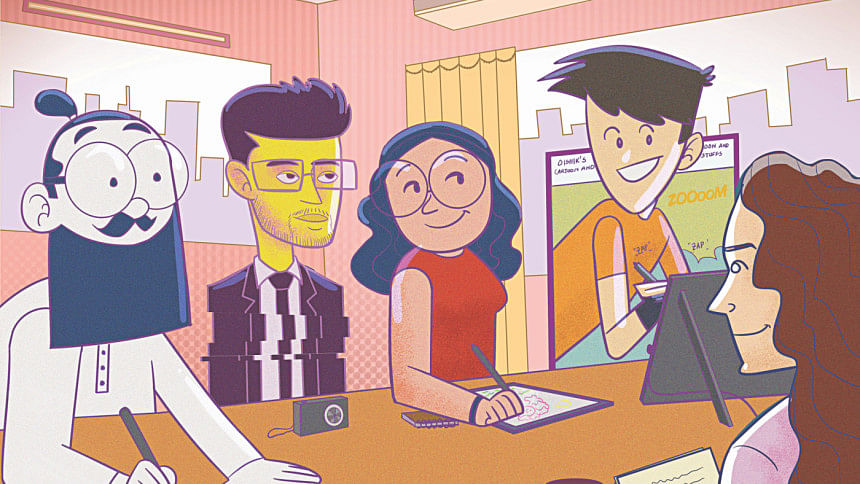
A glance at most of our newspaper and magazine pages, local art galleries, Facebook and Instagram communities, and even films and corporate campaigns reveals a thriving independent art scene. These platforms are all swept by illustrations, paint ings, sketches, photo collages, and cartoons and comics that reflect how both the artists and the audience engage with the socio-political and cultural climate today. Much of all of this is made digitally.
To explore what goes into making art digitally, The Daily Star spoke to five artists of varying backgrounds who started out young and who create using the digital medium. Reesham Shahab Tirtho is a Dhaka-based illustrator, cartoonist, and graphic designer who is also an architect and academic. His multi-disciplinary studio, "Studio Terracotta", has been working to create sustainable and climate-responsive architecture since 2015. Ata Mojlish, whose recent exhibition Truce - Juddhobiroti at Dwip Gallery in Lalmatia kicked up quite a storm, has been working as a visual communicator around the world for 10 years. His work focuses on image manipulation, what he terms as "digital reconstruction of the image". Nafia Jahan Monni completed an MFA degree in Fine Arts from the University of Dhaka in 2012. She selects subjects of art from the environment around her; while painting is her passion, Monni leans towards creating illustrations, doodles, and character designs. Finally, Oishik Jawad is a freelance cartoonist and comic book artist currently studying BBA in Marketing at the Bangladesh University of Professionals (BUP).
Sarah: How and why did you start drawing/ painting? And why digital art?
Reeham Shahab Tirtho: There was no particular reason. I have always loved to paint since my childhood. Architecture—which is my background—also required me to draw a lot, conceptual drawing in particular. It is a powerful language. But more and more people are travelling into the digital paradigm. My own journey with it started around 2015 when I opened my own studio and started working with cartoons, illustrations, etc.
Ata Mojlish: When I first started dabbling in art, I feel that initially it was for the wrong reasons—for popularity and appreciation—but later it became about self-expression. I would take a photograph and it would have to be tweaked and improved upon, because I wasn't as skilled with it at the time. That was how I stumbled upon the digital medium.
Nafia Jahan Monni: Traditional painting requires a lot of space and equipment—paper, canvas, colours, pencils, other utensils. Painting digitally is easier in comparison. It requires no space and not much extra equipment, and so I veered towards this medium after finishing my academic training.
Oishik Jawad: I use the digital medium to make cartoons and comics, not to design per se. I've always wanted to be a professional cartoonist and comic book artist. Most artists these days are drawing digitally, and once I got in touch with the professionals in the field, I moved to drawing digitally. The medium makes it easy to integrate oneself into others' workflow—I don't need to scan my drawing and send it to someone, I can just share my work with them.
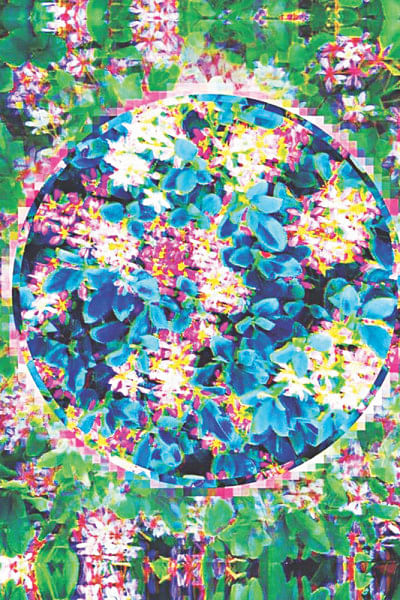
Sarah: Do you have a design philosophy?
Tirtho: It depends from case to case. Political issues motivate me when something urgent is going on around me. But when I'm designing a book cover for instance, in that case the work becomes entirely about what the client wants. When I draw for myself—which becomes difficult and I should try to do it more—I tend to draw things related to my family and kids. I have plans to make a series for children.
Ata: My art isn't about influencing anyone. I simply try to explore what's going on inside me—my reaction to the world around me. If that conveys a message to someone else, well, then that's great.
Monni: I like drawing character-driven, physical pieces more. It helps me analyse the landscape around me and explore the meaning and essence of characters and stories through a process of shape-giving.
Oishik: Comics, animation, and cartoons on TV inspire me the most, all of which is made digitally now. I've grown up watching cartoons and I like what the characters stand for. In terms of visual style, I love indie drawings, drawings by artists who are self-dependant and perhaps not working with big names like DC or Marvel, but smaller industries. Their drawings tend to be very different. The online indie scene really inspires me.
Also, there are no formal institutions to teach digital drawing here in Bangladesh and yet the artist community has taught itself so much on its own, either through online courses or self-practice or whatever else it takes. That inspires me a lot.
Sarah: What are the challenges and freedoms involved in working in this field?
Tirtho: I don't think the digital medium is right for an artist who is just starting out. It can prevent them from developing their own style—a lot of the digitally produced visual work looks identical these days—and from learning traditional anatomy and basic composition. Being overly dependent on drawing digitally from the very beginning can be detrimental in my opinion. It can also allow one to become famous with minimal hard work—this can be good or bad. On the plus side, a digitally prepared visual, during a social media uprising, can reach and inspire many people in a very short time.
Ata: There may be financial and other limitations, but I wouldn't really call them challenges. I firmly believe that the best creative work pours out of tension, obstacles, trying circumstances. We can choose to think of them as struggles or as inspirations. But the field also allows one to reach such a large audience so fast. The biggest freedom in digital art, for me, is how it lets you tweak, adjust, and manipulate images to achieve a multitude of meanings and messages.
Oishik: The entire digital scene is very online-based and the community is quite small. To enter this market one simply has to find the artist community, who are easily found online. I had no idea how to access them before I started out. But all it takes is a Facebook search for the people who are drawing cartoons in Bangladesh. There are a couple Facebook groups. Once you get acquainted with the community, if they can understand that you have talent and interest, they become extremely helpful.
But the one difficulty I've faced is getting paid. Initially, the pay is very minimal. I've had to do free work for many people and have not received payment even now for a lot of work that I completed in my first two years in the field, around 2016. This can be demotivating but eventually it pays off. Maybe I'm not earning as much as my friends who teach tuition classes, for instance, but I'm earning from doing something that I love.
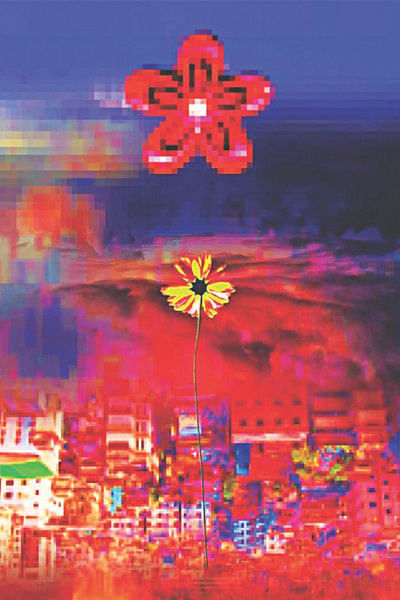
Sarah: Tell me about your experience with commissioned work. Where do you draw the line between maintaining your personal style or vision, and incorporating the client's specifications?
Tirtho: Thing is, most clients will come to you after seeing your work on Facebook or elsewhere online. So they already have an idea of your style, of what you can deliver, and whether you are the right person for the job. Beyond that, it's just a matter of staying on the same page with the client, which takes communication and a lot of patience. When the client knows what they want—and know that I know what they want—the job becomes easier. It's harder when they aren't sure of the brief themselves and expect you to surprise them. As an artist I have to completely understand what the client wants, to take the brief in detail, preferably in written format for clarity.
Ata: I remind myself that the client is paying me to design a certain visual, so in that case their specifications take priority. But I maintain a balance by drawing a clear distinction between commissioned works, and the visuals I make for myself, for a personal exhibition such as "Truce" at Dwip Gallery most recently.
Monni: The biggest difference lies in the amount of feedback. When I paint for myself, I tweak the work according to my own preferences. With commissioned work I have to constantly incorporate the client's feedback. It's all about understanding the client's taste and sometimes that can be difficult. But communication—continued communication—is key.
Oishik: Most of my early work centred around drawing caricatures for clients. The problem with that was, most clients would want a caricature because it's the new thing, but once they had seen the caricature they no longer wanted it. They wanted me to make it more realistic. So eventually I stopped doing caricatures.
continued from page 38
But besides that, since I work mainly with
comics, most clients understand what that entails and even when they don't, they're usually open to suggestions and explanations from the artist. Most corporate clients—newspapers, ad agencies, etc. —understand the medium. It's only some personal clients that expect more realistic work from cartoon drawings, in which case you just have to try to explain it to them.
Sarah: Any creative work—art in particular—is very personal. Art is also something that we tend to think of as permanent, something audiences can look at and perceive months, years, or even decades from when it is first made. In your opinion, at what point does one announce oneself as an artist? And how do you reconcile with the fact that your artwork might not be permanent, because the digital landscape is so fleeting and ever-changing?
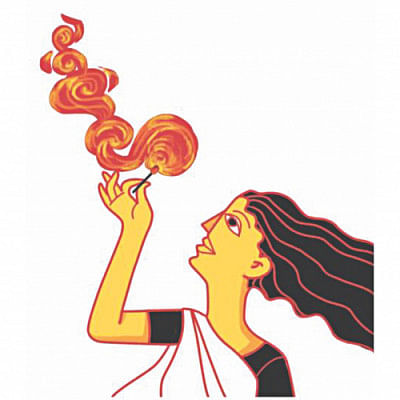
Tirtho: What the society terms as 'art' is just something that the artist makes for him/herself, so these are all just labels. But I think you're an artist when you can do nothing else, when you cannot live without painting or drawing or designing. Of course, it's only human to want respect and appreciation for your work, but you're an artist when you don't work simply for those rewards or because there is a pressure from clients, but because you feel like "I simply have to do it—amar chobi aktei hobe".
Ata: Artist, writer, musician, are all labels that the society puts on you and I don't put much stock by them. When I put a work out into the world, I have to trust that the audience will interpret it in their own way. So even if I don't necessarily agree with a client's specifications, I have to trust that the audience will receive whatever message the visual was trying to convey. This effect can be both instantaneous, or the work can continue to trigger different effects in the audience over a period of time. That feels worthwhile to me.
Oishik: The work becomes permanent based on the platform sometimes. I have made two comic books and another one is in the works. Whether anyone likes them or not, they're going to be there as art pieces in themselves.
However, I'm definitely aware that most of my hard work, especially the commissioned work, is not permanent, but it doesn't bother me very much. The impact my art has in that very moment and the enjoyment that I get from creating it makes up for it.

 For all latest news, follow The Daily Star's Google News channel.
For all latest news, follow The Daily Star's Google News channel. 


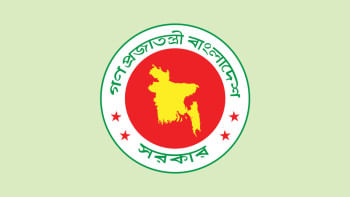
Comments